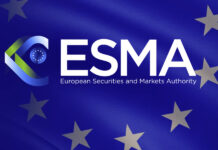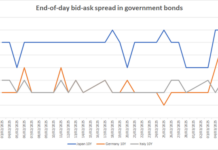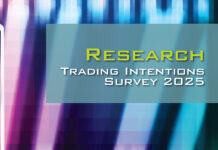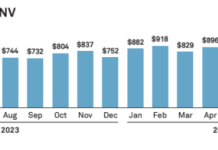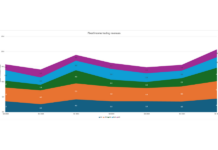When Bloomberg announced, in Q4 2024, that it was to start charging dealers for using FXGO, its foreign exchange trading service, a number of sell-side firms were up in arms. The additional costs would amount to between US$5-10 million dollars a year for top tier banks, one source noted, without any additional value being offered by the service.
That anger was not universal. Other banks said that using Bloomberg services extensively meant that the net value offered was greater than the additional costs that they faced.
The fees will begin to be imposed on 1 April 2025. The fee schedule is similar to those of its peers in structure and complexity, and is close to that used in fixed income.

“FX trading requires a thoughtful and dynamic convergence between dealer, client, process, and technology – FXGO helps achieve this by providing intuitive workflows that facilitate seamless access to FXGO’s global liquidity pool,” says Tod Van Name, global head of FX electronic trading at Bloomberg. “With the introduction of the rate card, we are reinvesting into FXGO to bring to market new features and workflow solutions to benefit both our buy and sell-side client base with a particular focus on portfolio trading, dealer efficiency and decision support capabilities.”

To remain competitive, Bloomberg reportedly priced its services at approximately 10% below those of rivals such as FXAll, owned by LSEG, and 360T, owned by Deutsche Boerse. The exact measure is hard to assess due to the structure of fee schedules that alter fess based on a range of dynamics.
However, sources report that after the announcement of Bloomberg’s fee imposition Q4 2024, none of its rivals dropped their fees, as might be expected in order to compete for market share. Fees either held, or increased.
Getting a like-for-like price comparison between platforms is nearly impossible due to the entirely unique structures for categorising liquidity provider/market maker activity levels, product specific pricing, and netting of cross product activity.

For example, 360T uses a points-based system to determine the tariff a liquidity provider (LP) is on for the coming billing period. Points are based upon a quarterly assessment of the total level of activity conducted by the LP on 360T as a group, over a rolling four-quarter look-back period. They are calculated based upon a common rate card and include activity on the various trading facilities plus market data and platform fees. Point thresholds are adjusted annually in line with the average daily volume (ADV) growth of 360T group over the past year. Its fee schedule has remained in place since Q1 2024 with no revisions.
It allows the trading of FX forwards, swaps, strategies, options, non-deliverable forwards (NDFs), non-deliverable swaps and non-deliverable strategies, with it describing an ‘FX strategy’ as an FX swap consisting of two FX forwards. 360T declined to comment for the story.

FXAll lets market-makers select a silver, gold, or platinum plan with different fee-reduction incentive schemes associated with each, for spot, swaps forward and options. It launched a new fee schedule on 1 March 2025, of which it had notifiied in January 2025.

The new schedule included formatting changes to the Request For Quote (RFQ) Transaction Fee Schedule, RFQ Transaction Fee Discounts with increases to the Accumulated Transaction Fee Discount thresholds for Platinum Plan subscribers, and an introduction of a US$1,500 Algo Monthly Minimum, Algo Accumulated Transaction Fee Discounts, and Algo Change Fees in respect of changes to a provider’s Algo setup.
A source close to the platform reported that there had been no change for the last two years.
Bloomberg’s approach includes incentive discount rates based on ranking in the top 25 liquidity providers, but it is also offering a 50% discount on fees in 2025 and a 25% discount in 2026, with full fees only applying in 2027.
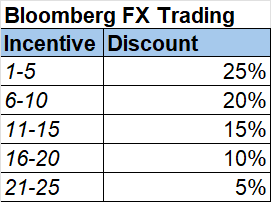
Although Bloomberg does not release data on its revenues, industry sources estimate that annual average FX spend on FXGO is expected to be about US$10 million each for of the top 5 brokers, US$$5 million for the next 6-10, US$2.5 million for number 11-15, with US$1.5 million for 16-20, US$1 million for 21-25 and about US$100,000 a year for those below top 25.

Sources also reported that Bloomberg has an overall strategy to migrate away from its historical 100% of revenue from terminals to delivering US$10 billion a year from terminals and US$6 billion from other sources such as transaction fees, by 2027, with a 50/50 split across terminals and other services to deliver US$20 billion by 2030.
Bloomberg declined to comment on these figures.

Brad Bailey, research director at Burton Taylor Consulting, says, “The terminal is a crucial part of the ecosystem for so many players, but if you look at the way technology is evolving, machine learning and AI adds to the demand to buy and access to content outside of the terminal. The terminal structure is organized for human consumer. It has all the tools that a person needs to find out anything about the market they’re interested in. But with so much of the market being machine fed, it makes sense that Bloomberg would have strategic imperatives to consider driving revenues outside of the terminal.
©Markets Media Europe 2025





